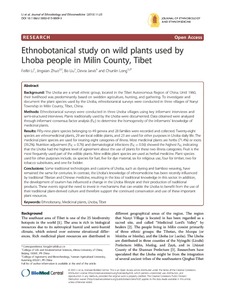Resource information
The Lhoba are a small ethnic group, located in the Tibet Autonomous Region of China. Until 1960, their livelihood was predominantly based on swidden agriculture, hunting, and gathering. To investigate and document the plant species used by the Lhoba, ethnobotanical surveys were conducted in three villages of Nanyi Township in Milin County, Tibet, China.
Ethnobotanical surveys were conducted in three Lhoba villages using key informant interviews and semi-structured interviews. Plants traditionally used by the Lhoba were documented. Data obtained were analyzed through informant consensus factor analysis (FIC) to determine the homogeneity of the informants’ knowledge of medicinal plants.
Fifty-nine plant species belonging to 49 genera and 28 families were recorded and collected. Twenty-eight species are ethnomedicinal plants, 29 are local edible plants, and 23 are used for other purposes in Lhoba daily life. The medicinal plant species are used for treating eight categories of illness. Most medicinal plants are herbs (71.4%) or roots (39.2%). Nutrition adjustment (FIC = 0.76) and dermatological infections (FIC = 0.56) showed the highest FIC, indicating that the Lhoba had the highest level of agreement about the use of plants for these two illness categories. Fruit is the most frequently used part of the edible plants. Nine edible plant species are used as herbal medicine. Plant species used for other purposes include, six species for fuel, five for dye material, six for religious use, four for timber, two for tobacco substitutes, and one for fodder.
Some traditional technologies and customs of Lhoba, such as dyeing and bamboo weaving, have remained the same for centuries. In contrast, the Lhoba’s knowledge of ethnomedicine has been recently influenced by traditional Tibetan and Chinese medicine, resulting in the loss of traditional knowledge in this sector. In addition, the development of tourism has influenced a change in the Lhoba lifestyle and their production of traditional products. These events signal the need to invest in mechanisms that can enable the Lhoba to benefit from the use of their traditional plant-derived culture and therefore support the continued conservation and use of these important plant resources.


